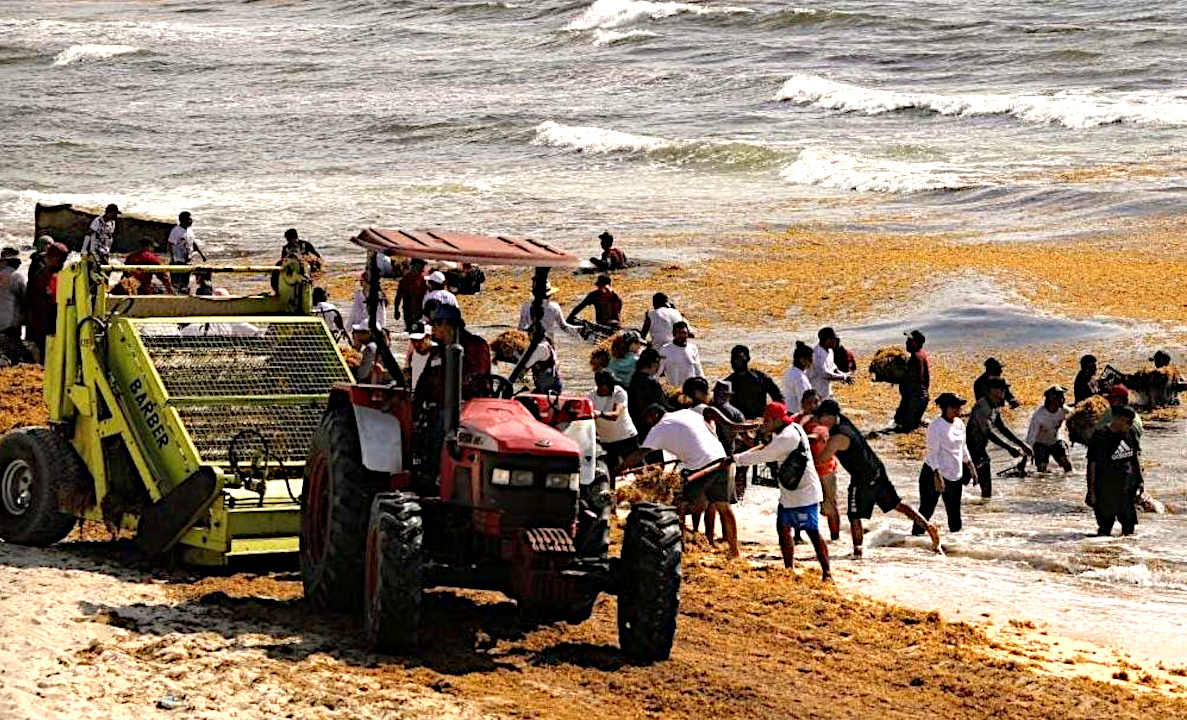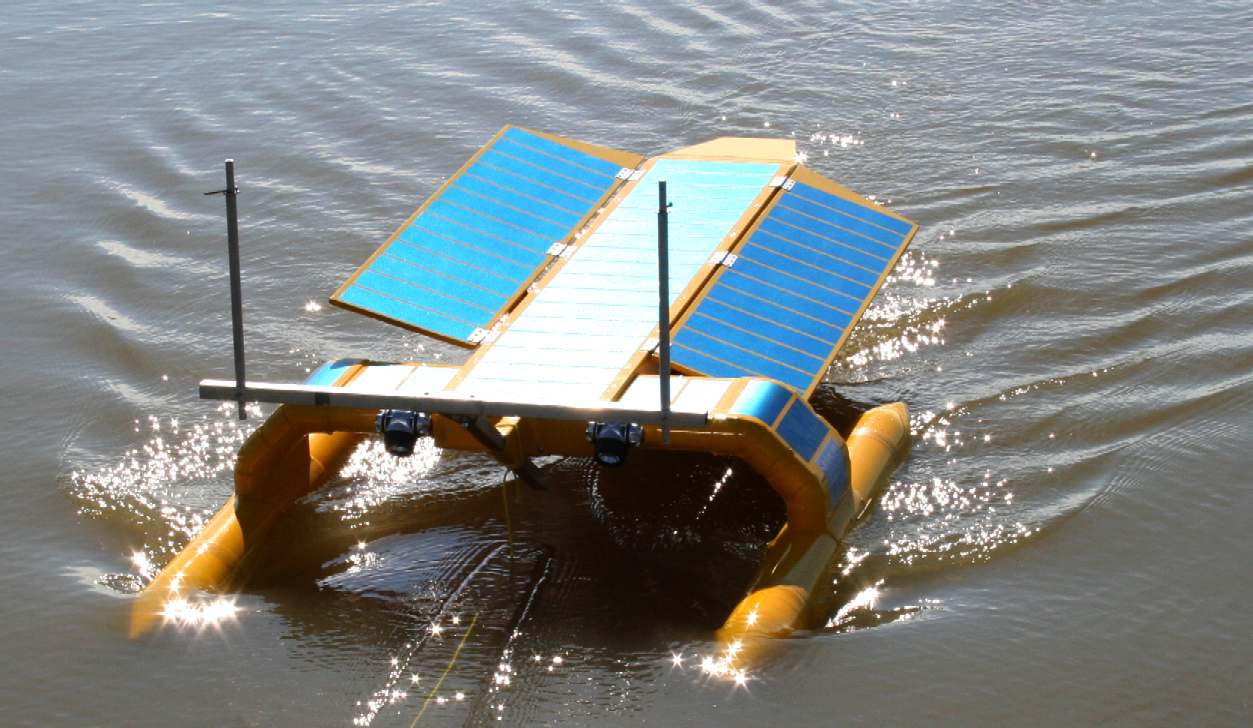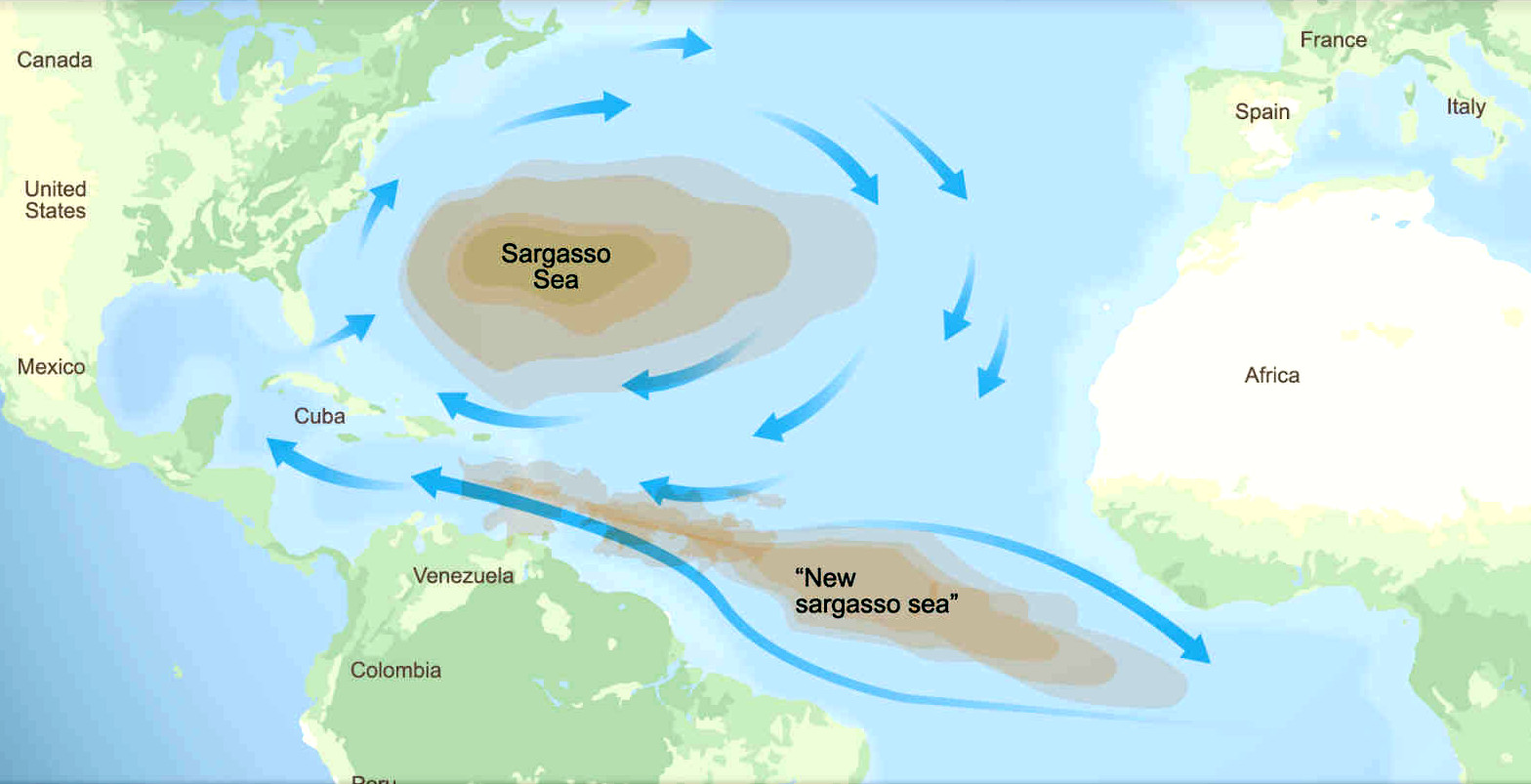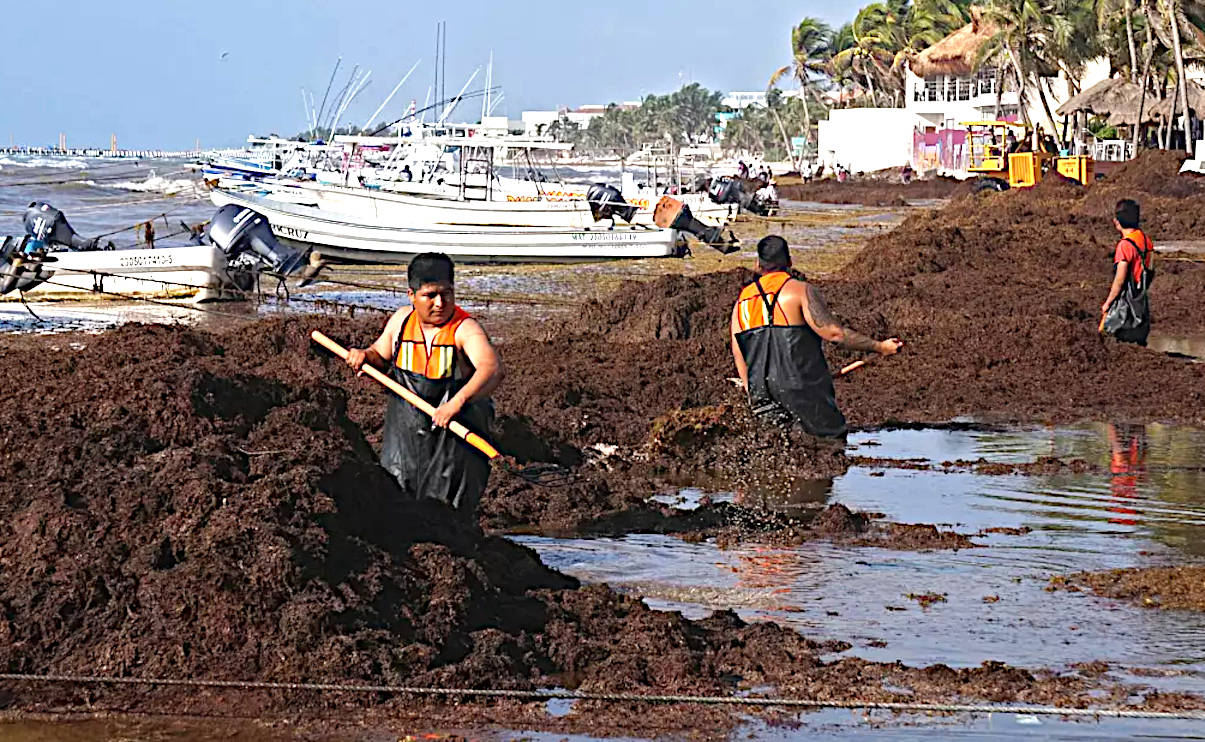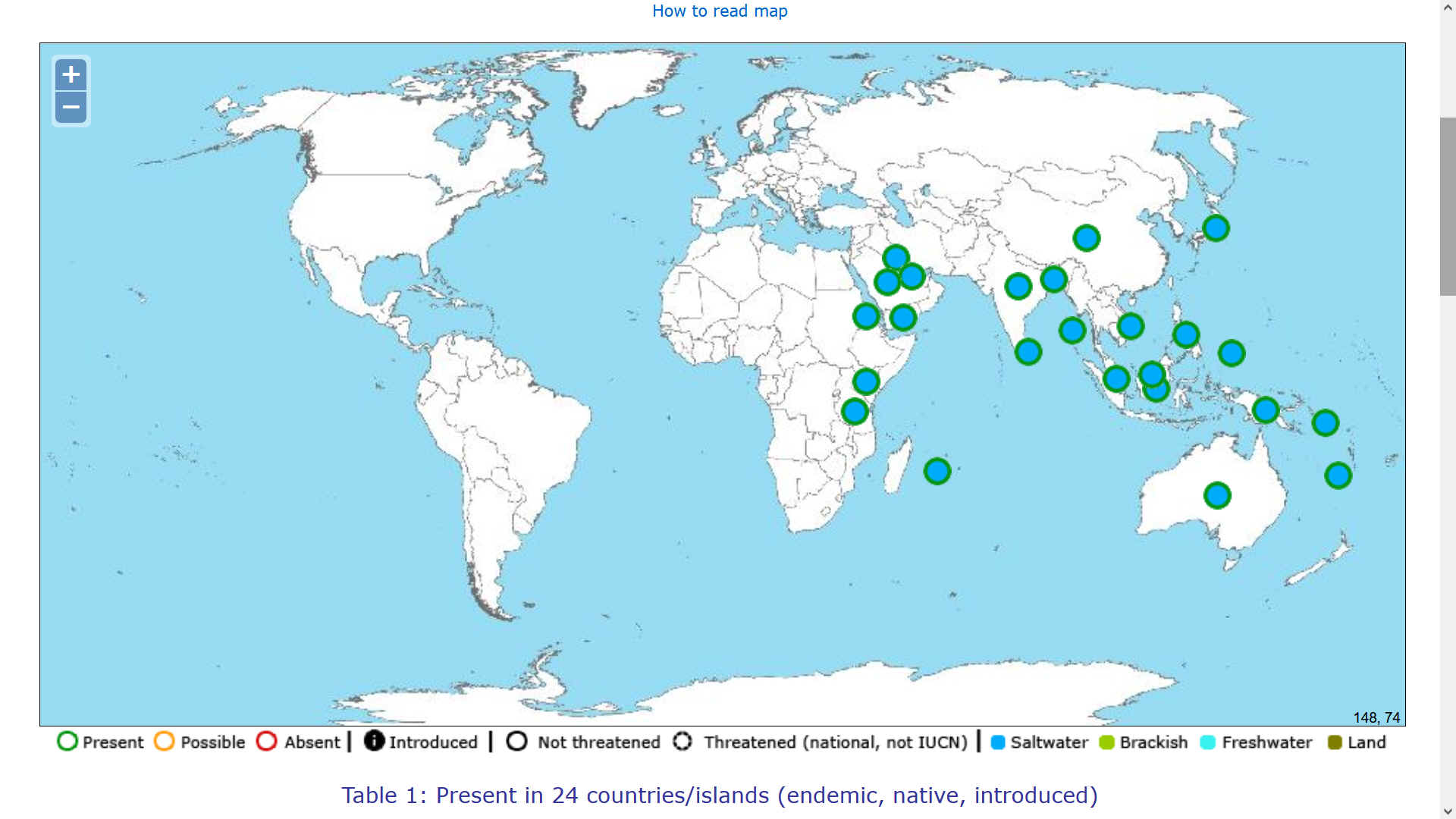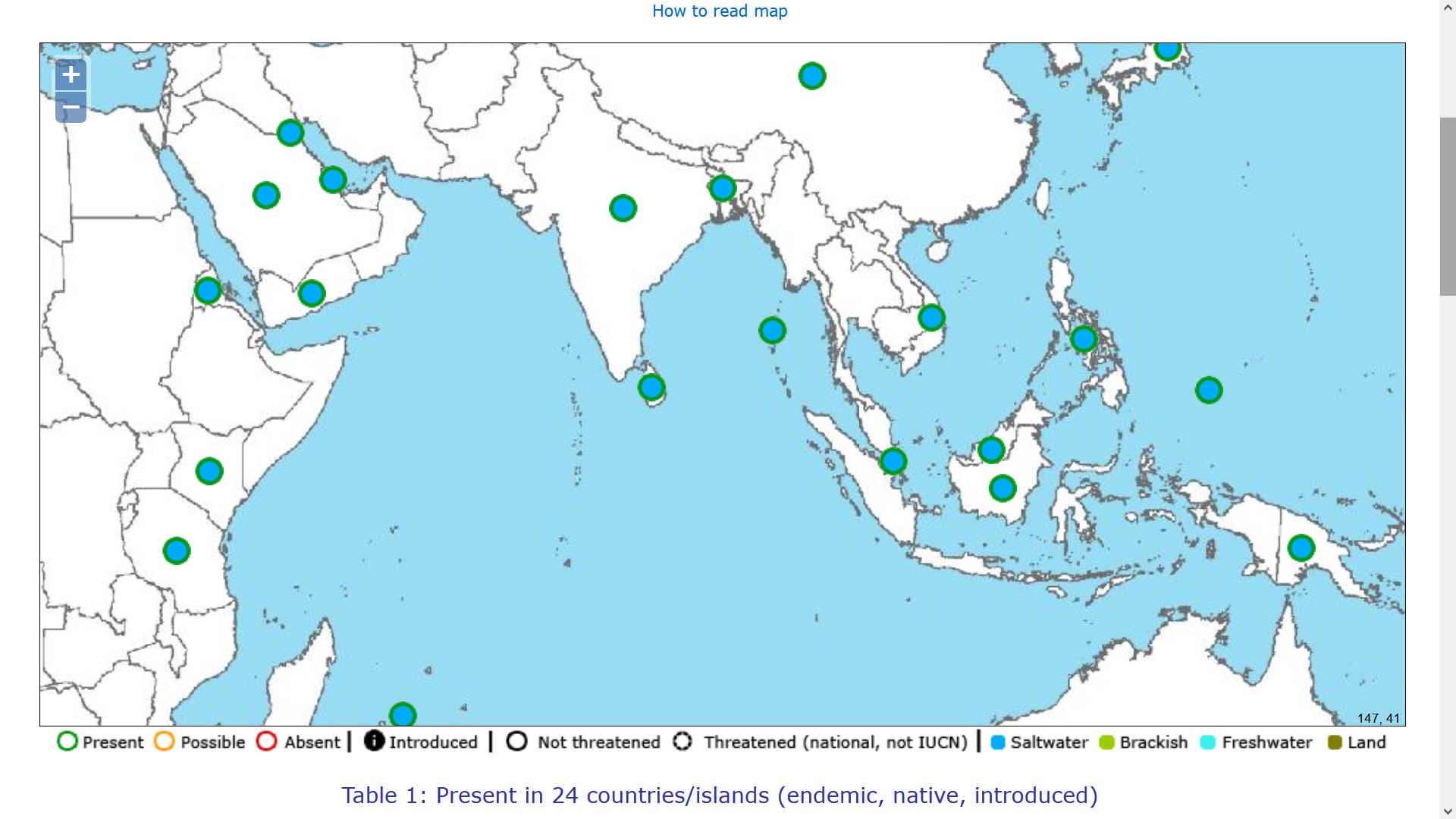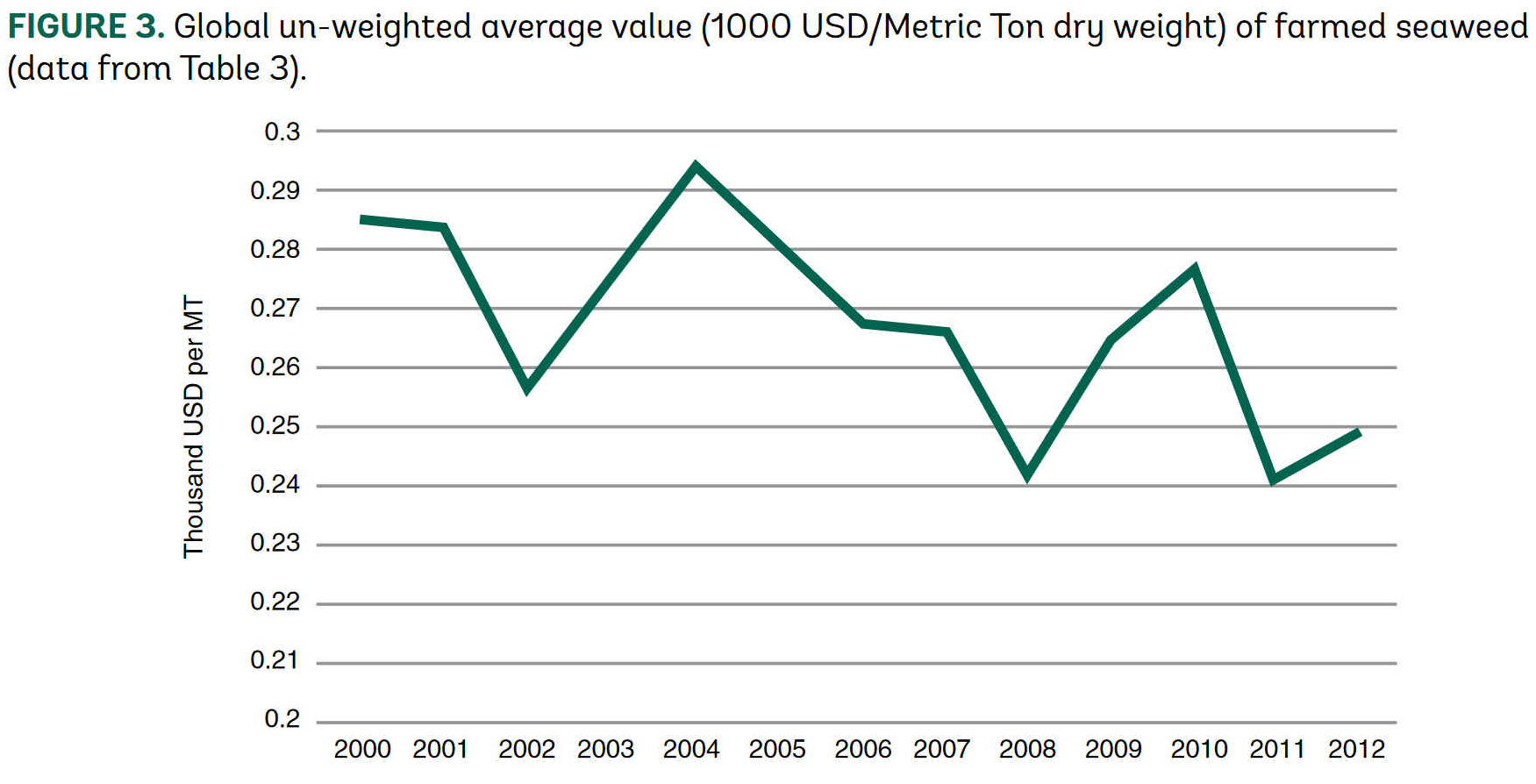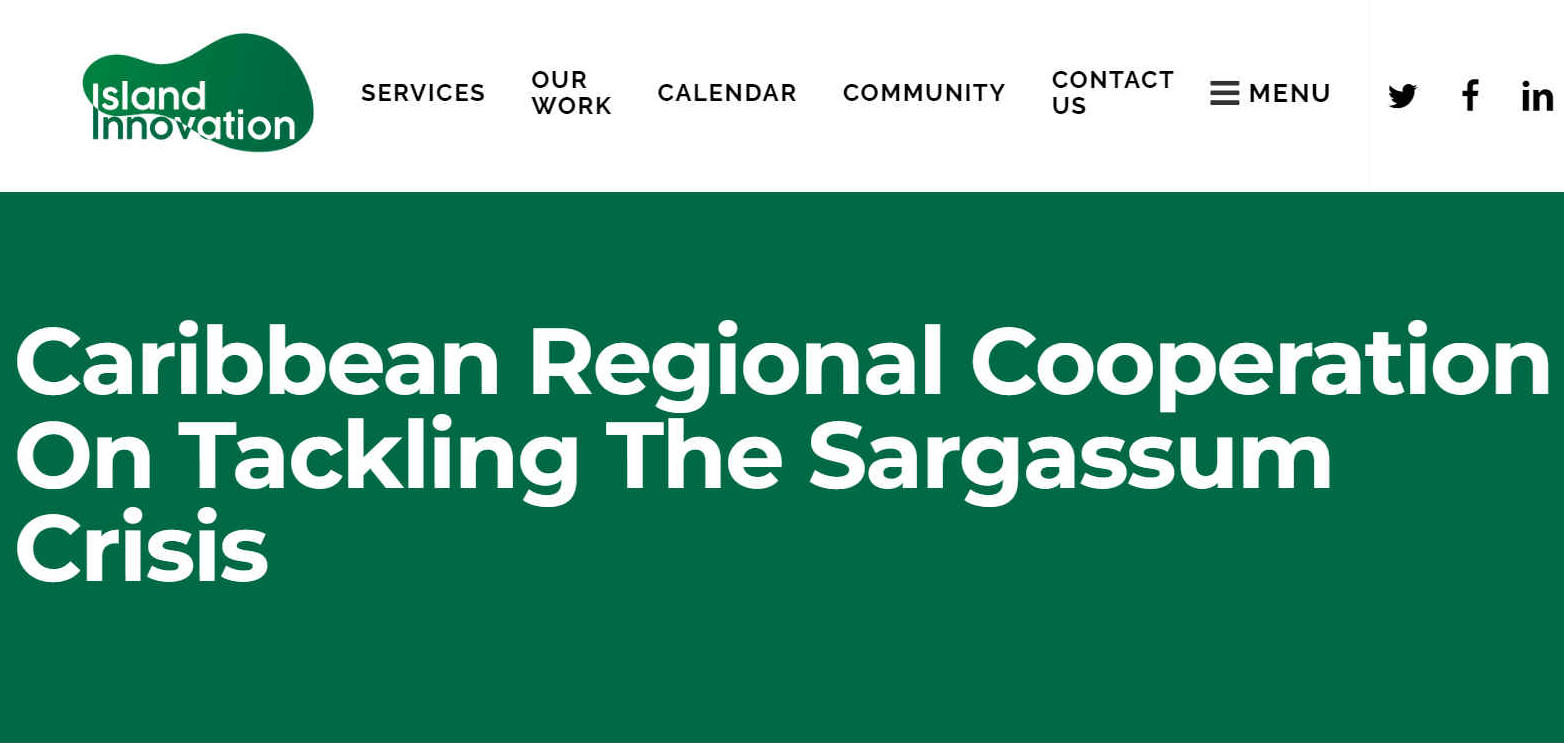|
SARGASSUM & THE CARIBBEAN CRISIS
Please use our A-Z to navigate this site or return HOME
|
||
|
Sargassum is found in the tropical oceans of the world. They are also called planktonic (free-floating species) which inhabits coral reefs and shallow water and are the genus of brown algae of sargassaceae family. These are small in size and have leaf-like toothed edges. Some of its species are reproduced sexually and pelagic species are reproducing by fragmentation. The term Sargassum was initiated by Portuguese sailors who found it in the Sargasso Sea. They are brown genus which may grow to a length of meters.
Sargassum is a genus of large brown
algae that includes over 300 species. Two prevalent species in the
Atlantic Sargassum natans and Sargassum
fluitans, are found in free-floating mats, held afloat by gas-filled bladders.
Seaweeds such as kelp and sargassum, from the Sargasso Sea, might be harvested in bulk using adaptations of the SeaVax concept:
MARINE COMBINED HARVESTER - The basic SeaVax machine is seen here as a proof of concept (working model). It was designed to filter macro & micro plastics from seawater - in bulk, and recover ghost fishing nets of up to 150 tons. It was to be solar and wind powered when conceived in 2015. Today, the vessel would need more power if a fleet of them are to deal with something like 24 million tons of sargassum a year. Around triple the 8 million ton capacity envisaged for marine litter. Any revised specification would probably need to include renewable hydrogen in the energy equation. The Foundation is open to expressions of interest, looking for partners in the affected regions, who may be looking to operate a business, working with a charity that will provide IP, marketing and technical support.
COSMETICS - FERTILIZERS - FOODS - MEDICINES - MINERALS - PACKAGING - SUPPLEMENTS - VITAMINS
SARGASSUM - The giant brown seaweed, having shown that it can spread from North to South Atlantic oceans, could spread to the Indian and Pacific oceans as a potentially invasive species.
The Cartagena Convention was ratified by 26 United Nations Member States in the Wider Caribbean Region, but not the European Union. It covers the marine environment of the Gulf of Mexico, the Caribbean Sea and the areas of the Atlantic Ocean adjacent thereto, south of 30 north latitude and within 200 nautical miles of the Atlantic Coasts of the United States.
There is nothing to prevent other technology champions coming forward to form Gulf or Caribbean island cooperatives - or both. The Cleaner Ocean Foundation will donate a free licence to any bona-fide research group, to utilize the SeaVax™ trademark for grant application purposes, provided that technology advancements are shared for the common good. In the alternative, the Foundation will join any cooperative that is serious about working together to beat the manifold state of emergency situations. Expressions of interest welcomed. Please contact our Managing Trustee in the first instance.
With
an efficient method of harvesting the macro-algae, there is
potential to turn a nuisance into opportunity:
Biomass can be used as fuel or for the generation of biofuels, etc. Though, such use may be cause for concern in terms of combustion gases and global warming.
FOR USE AS A FERTILIZER
Fertilizers: Organic fertilizers are produced for the cultivation of horticulture crops like kharif, rabi, zaid, food crops, and plantation. The agricultural world is facing a fertilizer shortage.
Sargassum has a high content of nitrogen and other important nutrients, which can be used to fertilize fields if done properly. Various species of sargassum have potassium chloride; they are used for making fertilizers in different countries like US, Japan, South India, France, and England. In South India, these are used as manures for plantations of coconut. They are also used for producing various crops.
Plantation: You can use sargassum products as manures for plantations. It may help you in better yielding of plants and kitchen gardens. It provides for organic veggies and fruits.
MATERIALS FOR THE FOOD & COSMETIC INDUSTRIES
Sargassum also helps in making food products which has their own nutritive value and composition. These products are prepared under hygienic conditions; it can be served as soups, salads, veggies, curries and many more. Gel form: Sargassum is also used as a gel form. This gel is used for the manufacturing of agricultural products. Snacks form: Sargassum is also available in snacks form. Different flavors of seaweed snacks are available online. It could be either in chips, nuggets, and sushi or in rice form.
Sargassum is especially rich in sodium alginate, a polysaccharide that is often used as a thickener in food products (tomato ketchup) and even cosmetics. Sargassum is used for making agar which is obtained from several species. They are used in several ways for example, in preparation of jellies, ice cream, and other desserts. It can be also used for purifying liquids and in textile sizing. We can also use agar in preparing cosmetics, shoe polishes, shaving creams. It is also used by science students for media preparations.
Sargassum is also used as a source of food such as food supplements, pills, seafood, rice, sauce, curries, vegetables, soups, and seasonings.
FOR MEDICAL USE - MEDICINES
Most of the seaweeds are salty in taste. The presence of iodine in sargassum is used for maintaining thyroid gland in our body. It helps in preventing goiter testicular pain and swelling. It helps in maintaining healthy blood sugar and blood pressure.
Different minerals like calcium, zinc, phosphorus, sodium, copper, etc are the main nutritive constituents of the body. The daily intake of iron, zinc helps in controlling anemia, high menstrual loss, and pregnancy.
Sargassum also has its own nutritional value. It has different nutrients like essential amino acids, minerals, carbohydrates, protein, cellulose, vitamins, carotenoids, and fatty acids. This nutrient supports antioxidant and antibacterial properties.
Sargassum also contains high concentrated saturated fatty acids, polyunsaturated fatty acids; even it has a low level of lipid.
Sargassum is enriched with vitamins. Different vitamins A, B, C, D, E, and K help in different ways. It may help in maintaining healthy bones, tissues, eye health, and healthy skin.
HEALTH PRODUCTS, SUPPLEMENTS
Sargassum also helps in maintaining our health. Supports in blood pressure: Some species of sargassum helps in maintaining the blood pressure of the body. It keeps you healthy and active throughout the day. Supports thyroid health: Sargassum is rich in iodine, thus it helps in maintaining thyroid gland of the body. It also helps in preventing hypothyroidism.
Anti-cancer health: Sargassum also helps in controlling
cancer. It helps in the proliferation of anaplastic cells in the body. Acts as anti-coagulant property: It also helps in preventing coagulation as it helps in stopping blood from clotting. Maintains sugar levels in the body: Sargassum also helps in maintaining sugar levels in the body. When we add seaweed to our diet, it helps in improving blood sugar levels in our body. Helps in losing weight: Sargassum helps in reducing excessive fat from the body. It may help in delaying hunger and you can lose weight.
ISLAND
NATIONS
“In all regions combined — the tropical Atlantic, the Caribbean Sea and the Gulf of Mexico — the total sargassum amount increased from 18.8 million tons in May 2022 to 24.2 million tons in June 2022, thus setting a new historical record,” the University of South Florida Optical Oceanography Lab reported.
SPREAD OF THE CONTAGION
Even if we transition to renewables immediately, global warming will not reverse for 30-50 years at best, and that is with a fair political wind. Meaning that the conditions for sargassum to populate in welcoming equatorial waters (rich in nutrients) around the globe, remains a distinct possibility.
Especially where the water temperature is never lower than 18С degrees (+64F degrees), as in the Sargasso Sea. Such as these regions:
Atlantic - North & South Equatorial Banda Ceram Molucca & Timor Seas Pacific Ocean - North & South, Equatorial Belt (Costa Rica, Ecuador, Panama regions)
Seas and oceans in these latitudes could become inundated with macro algae, if the rafts of floating seaweed manage to navigate less hospitable barriers, such as colder regions. Which at the moment, Cape Horn and the Cape of Good Hope appear to offer some protection from invasion. See below for the current (unconfirmed) state of the art.
HOW TO READ THE MAP - The literature species report in a country is represented by an icon (a circle) in the middle of the country polygon.
Important: a report in the literature does not necessarily mean that the species is currently present in the country! There are errors in literature, misidentifications, and some species have been locally or globally extirpated or eradicated.
HOW
TO INTERPRET THE MAP - The icon in a country polygon indicates that the species has been reported at least once in the country, BUT NOT NECESSARILY that it is present IN THE ENTIRE COUNTRY.
This is particularly so for large countries such as Brazil, USA, Canada, Russia, China, India, Indonesia, Australia, etc.
LINKS & REFERENCE
https://agrocorrn.com/what-is-sargassum/
IN ABUNDANCE - Seaweed as a bed on the Australian coast.
|
||
|
The
United Nations Environment Programme (UNEP) and other organizations, have written
(white) papers suggesting that the sargassum crisis in the
Caribbean Sea and Gulf of Mexico, might be turned into an opportunity, via economic harvesting of the nuisance seaweed, and conversion to a cash crop.
FERTILIZERS - FOODS - MEDICINES - MINERALS - PACKAGING - SUPPLEMENTS - VITAMINS
The above are a number of areas of potential commercial applications for suitably harvested sargassum, that may help those nations affected, to cope with the unwanted influx, that is ruining their beaches and more.
|
||
|
|
||
|
PROPOSED: SARGASSUM COOPERATIVE CIC
The "Sargassum Cooperative CIC" is a proposed consortium of affected Governments, the aim of such group being to develop a cost-effective system for the sustainable, proactive removal and long-term management of pelagic Sargassum seaweed in the Mexican Gulf and Caribbean Sea - much as the excellent example document from the Government of Antigua and Barbuda in 2018 sets out. Save that it might be an advantage if the efforts of individual administrations were to be coordinated with shared cost and knowledge transfer, for greater development savings and Satellite guided attack on the scourge, using zero emission harvesting equipment.
The above are acknowledged areas of Blue Growth, agreed by most countries, including Kenya, Bangladesh, Europe, the Americas, and Australia.
|
||
|
|
||
|
CRISIS 2022 - Sargassum is found in the tropical oceans of the world, but has become a serious issue on the beaches of the Gulf of Mexico and Caribbean islands, who are dependent on tourism to bolster their economy. What is at present seen as a crisis situation, and declared state of emergency, could be turned to economic advantage with machines like the SeaVax-Calypso™ (by way of example), if adapted to harvest bulk quantities of the large brown macro-algae, for food, medicines and fertilizers - before it chokes the shores downstream of the Sargasso Sea, to include the African west coast.
Anchovies | Bass | Bream | Catfish | Clams | Cod Coley | Crabs | Crayfish | Eels | Grouper | Haddock | Hake | Halibut | Herring | Jellyfish Krill | Lobster | Mackerel | Marlin | Monkfish | Mullet | Mussels | Oysters | Perch | Piranha | Plaice | Pollock | Prawns | Rays | Sablefish | Salmon Sardines | Sargassum | Scallops | Seaweed | Sharks | Shrimp | Skate | Sole | Sprat | Squid | Sturgeon | Swordfish | Trout | Tuna | Turbot | Whiting
|
||
|
|
||
|
Please use our A-Z to navigate this site
This website is Copyright © 2022 Cleaner Ocean Foundation Ltd, an equal opportunities company. This website is provided on a free basis as a public information service. Copyright © Cleaner Oceans Foundation Ltd (COFL) (Company No: 4674774) 2022. Solar Studios, BN271RF, United Kingdom. COFL is a charity without share capital.
|
